Public housing estates in the Kai Tak development area
The following is an overview of public housing estates in the Kai Tak development area, Kowloon City District, Hong Kong, including Home Ownership Scheme (HOS), Private Sector Participation Scheme (PSPS), and Tenants Purchase Scheme (TPS) estates.
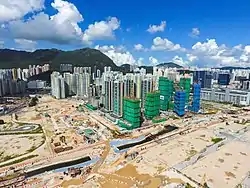
History
In 1998, the Hong Kong International Airport relocated to Chek Lap Kok, clearing the way for a redevelopment of the Kai Tak lands. In 2006, the Planning Department outlined plans to build two new public estates on part of this brownfield site. The two estates, called Kai Ching (啟晴) and Tak Long (德朗), opened on the former north apron in 2013/2014.[1]
Overview
| Name | Type | Inaug. | No. Blocks | No. Units | Notes | |
| Kai Ching Estate | 啟晴邨 | Public | 2013 | 5 | 5,200 | |
| Tak Long Estate | 德朗邨 | Public | 2013 | 9 | 8,164 | |
| De Novo | 煥然壹居 | Resettlement | 2017 | 4 | 484 | Urban Renewal Authority Flat-for-Flat Scheme housing for residents displaced by urban renewal. |
| Kai Long Court | 啟朗苑 | HOS | 2019 | 2 | 683 |
Kai Ching Estate
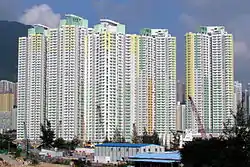
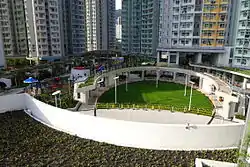
Kai Ching Estate (Chinese: 啟晴邨) consists of six residential buildings completed in 2013.[2] It houses around 5,200 flats for 13,300 residents and shares the "Ching Long Shopping Centre" with Tak Long Estate. Kai Ching Estate was built by China State Construction Engineering (Hong Kong).[3]
Like other public housing estates in Hong Kong, the construction of Kai Ching Estate made use of prefabricated components including precast facades and staircases, semi-precast slabs, and precast kitchens and bathrooms.[4] Kai Ching was also a pilot estate for the use of precast water taps.[3]
The estate incorporates a number of energy and water saving features. Renewable energy sources include solar panels on the housing block rooftops, and lift motors that can generate power when the lift is carrying a heavy load down, a light load up, or under braking conditions. A district cooling system cools non-domestic facilities including the shops, kindergartens, and estate offices. A rainwater collection system is used for irrigation.[4]
In 2014, one resident of Lok Ching House shot and killed another resident, sparking a 12-hour standoff with police. The gunman, a mainland immigrant, shot himself and was declared dead in hospital. He was suspected of suffering from mental problems and had previously been jailed for assault.[5]
In 2015, water samples from Kai Ching Estate were found to be contaminated with lead, sparking a citywide scandal and the discovery of contaminated drinking water at many other buildings.[3] Pipe soldering samples taken from Kai Ching Estate contained 50 per cent lead.[6] In addition, Legionella bacteria was discovered at Mun Ching House.[7]
Houses
| English name | Chinese name | Type | Storeys | Completion |
|---|---|---|---|---|
| Hong Ching House | 康晴樓 | Non-standard block (Y-shaped) | 39 | 2013 |
| Lok Ching House | 樂晴樓 | 40 | ||
| Yan Ching House | 欣晴樓 | |||
| Sheung Ching House | 賞晴樓 | Non-standard block (cross-shaped) | ||
| Mun Ching House | 滿晴樓 | |||
| Yuet Ching House | 悅晴樓 | 35 | ||
Tak Long Estate
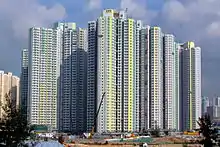

Tak Long Estate (Chinese: 德朗邨) consists of nine residential blocks completed in 2013.[8] It shares the "Ching Long Shopping Centre" with Kai Ching Estate.
Houses
| English name | Chinese name | Type | Storeys | Completion |
|---|---|---|---|---|
| Tak Pui House | 德珮樓 | Non-standard block (cross-shaped) | 35 | 2013 |
| Tak Loong House | 德瓏樓 | 40 | ||
| Tak Ying House | 德瑩樓 | |||
| Tak Cheung House | 德璋樓 | |||
| Tak Kei House | 德琦樓 | |||
| Tak Shan House | 德珊樓 | |||
| Tak Yiu House | 德瑤樓 | |||
| Tak Yu House | 德瑜樓 | Non-standard block (Y-shaped) | ||
| Tak Sui House | 德瑞樓 | |||
Tak Long Estate is in Primary One Admission (POA) School Net 34. Within the school net are multiple aided schools (operated independently but funded with government money) and two government schools: Farm Road Government Primary School and Ma Tau Chung Government Primary School.[9]
 Entry Plaza
Entry Plaza Historical Gallery
Historical Gallery Carpark Podium Jogging Track
Carpark Podium Jogging Track Children Playground
Children Playground Kindergarten
Kindergarten Tak Yiu House Entrance
Tak Yiu House Entrance Carpark
Carpark
De Novo
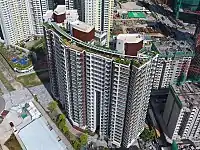
De Novo (Chinese: 煥然壹居) is a housing estate of the Urban Renewal Authority comprising four residential blocks and a two-storey commercial complex. It provides 484 flats of between 330 and 670 square feet each. Urban renewal in Hong Kong typically involves wholesale demolition of old urban districts and their replacement with high-end commercial and housing developments. Therefore, this project is intended to accommodate residents displaced by urban renewal projects.[10] De Novo is being constructed directly to the west of Tak Long Estate.
In April 2015, it was reported that some of the flats at De Novo will be offered up for subsidised sale at about 75 per cent of the market value. The scheme will target families who cannot afford private housing, but who are too rich to qualify for the Home Ownership Scheme.[11]
In light of the ongoing lead-in-drinking water scandal, the URA assured prospective buyers that plumbers made use of silver welding materials, and that experts were on hand to ensure no materials with lead were used. However, the Apple Daily newspaper took samples from each of De Novo's four blocks and found lead contamination up to 30 percent above the acceptable limit.[12][13]
Kai Long Court
Transportation
The estates are in proximity to Kai Tak station of the Mass Transit Railway. In February 2013, five of the eventual 25 pedestrian links to the Kai Tai development area were completed.[14] Four bus routes will also service the estates.
Kai Tak Cruise Terminal is also located nearby.
References
- "Kai Tak Development Progress Report as of September 2013" (PDF). Task Force on Kai Tak Harbourfront Development. Retrieved 27 April 2014.
Population intake of Kai Ching Estate (啟晴邨) commenced in July 2013. Tak Long Estate (德朗邨) will be completed in two phases before Q1 of 2014, to be followed by population intakes.
- "Kai Ching Estate, Kowloon City, Kowloon West". Hong Kong Housing Authority. Retrieved 27 April 2014.
- Lo, Arthur (13 July 2015). "Explainer: How the water lead contamination scare became a citywide concern". Hong Kong Free Press.
- "Case Study 1: Our New Sustainable Housing Development" (PDF). Housing Authority. Retrieved 16 September 2015.
- Lo, Clifford; Chan, Samuel; Lo, Wei (1 June 2014). "Gunman Li Tak-yan had a history of attacking neighbours". South China Morning Post.
- Nip, Amy; Cheng, Amie; Lo, Kinling (17 July 2015). "Buck stops with you, builders told". The Standard. Archived from the original on 25 November 2015.
- "Legionella detected at Kai Ching Estate". Hong Kong Government. 13 July 2015.
- "Tak Long Estate, Kowloon City, Kowloon West". Hong Kong Housing Authority. Retrieved 27 April 2014.
- "POA School Net 34" (PDF). Education Bureau. Retrieved 12 September 2022.
- "URA's Flat-for-Flat scheme at Kai Tak awarded BEAM Plus Provisional 'Platinum' rating for its sustainable building design". Urban Renewal Authority. 24 April 2013. Retrieved 1 September 2014.
- Fung, Fanny W.Y. (1 April 2015). "Hong Kong Urban Renewal Authority agrees to subsidised homes plan at Kai Tak". South China Morning Post.
- "Excess lead found in a water sample at URA's De Novo project". Hong Kong Economic Journal. 15 January 2016.
- Chu, Koel (16 January 2016). "Lead in water 30% over safety standards at Urban Renewal Authority's first subsidised flats – report". Hong Kong Free Press.
- Ho, Jolie (14 February 2013). "Work on five links to Kai Tak to be completed this month". South China Morning Post. Retrieved 31 December 2013.
The five links include two new footbridges and improvements to three existing subways.